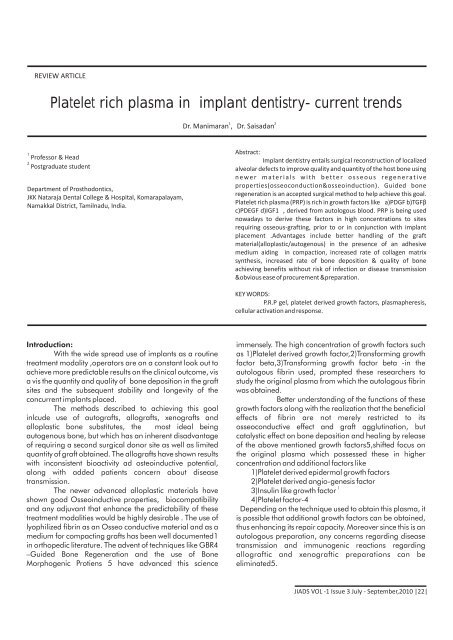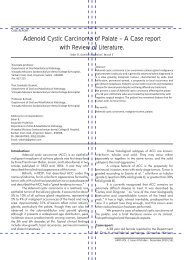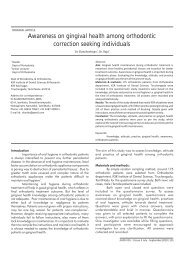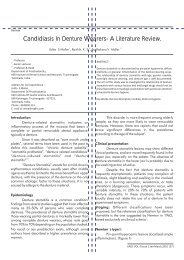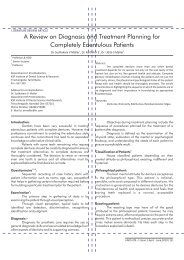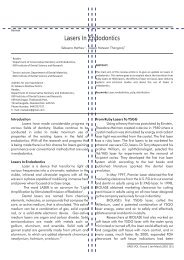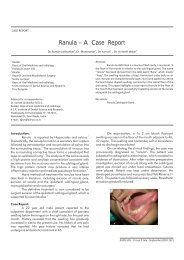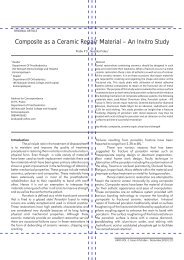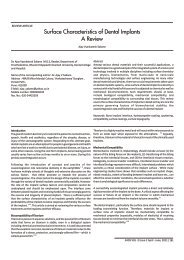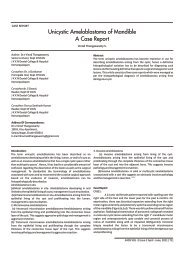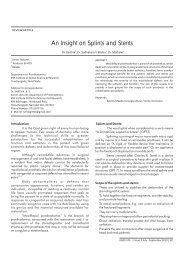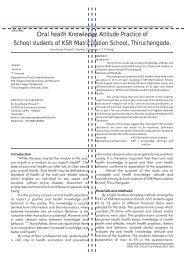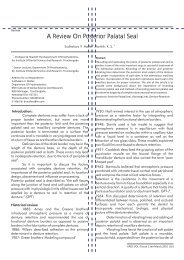Platelet rich plasma in implant dentistry - current trends
Platelet rich plasma in implant dentistry - current trends
Platelet rich plasma in implant dentistry - current trends
You also want an ePaper? Increase the reach of your titles
YUMPU automatically turns print PDFs into web optimized ePapers that Google loves.
REVIEW ARTICLE<strong>Platelet</strong> <strong>rich</strong> <strong>plasma</strong> <strong>in</strong> <strong>implant</strong> <strong>dentistry</strong>- <strong>current</strong> <strong>trends</strong>1 2Dr. Manimaran , Dr. Saisadan12Professor & HeadPostgraduate studentDepartment of Prosthodontics,JKK Nataraja Dental College & Hospital, Komarapalayam,Namakkal District, Tamilnadu, India.Abstract:Implant <strong>dentistry</strong> entails surgical reconstruction of localizedalveolar defects to improve quality and quantity of the host bone us<strong>in</strong>gn e w e r m a t e r i a l s w i t h b e t t e r o s s e o u s r e g e n e ra t i v eproperties(osseoconduction&osseo<strong>in</strong>duction). Guided boneregeneration is an accepted surgical method to help achieve this goal.<strong>Platelet</strong> <strong>rich</strong> <strong>plasma</strong> (PRP) is <strong>rich</strong> <strong>in</strong> growth factors like a)PDGF b)TGFβc)PDEGF d)IGF1 , derived from autologous blood. PRP is be<strong>in</strong>g usednowadays to derive these factors <strong>in</strong> high concentrations to sitesrequir<strong>in</strong>g osseous-graft<strong>in</strong>g, prior to or <strong>in</strong> conjunction with <strong>implant</strong>placement .Advantages <strong>in</strong>clude better handl<strong>in</strong>g of the graftmaterial(alloplastic/autogenous) <strong>in</strong> the presence of an adhesivemedium aid<strong>in</strong>g <strong>in</strong> compaction, <strong>in</strong>creased rate of collagen matrixsynthesis, <strong>in</strong>creased rate of bone deposition & quality of boneachiev<strong>in</strong>g benefits without risk of <strong>in</strong>fection or disease transmission&obvious ease of procurement &preparation.KEY WORDS:P.R.P gel, platelet derived growth factors, <strong>plasma</strong>pheresis,cellular activation and response.Introduction:With the wide spread use of <strong>implant</strong>s as a rout<strong>in</strong>etreatment modality ,operators are on a constant look out toachieve more predictable results on the cl<strong>in</strong>ical outcome, visa vis the quantity and quality of bone deposition <strong>in</strong> the graftsites and the subsequent stability and longevity of thecon<strong>current</strong> <strong>implant</strong>s placed.The methods described to achiev<strong>in</strong>g this goal<strong>in</strong>lcude use of autografts, allografts, xenografts andalloplastic bone substitutes, the most ideal be<strong>in</strong>gautogenous bone, but which has an <strong>in</strong>herent disadvantageof requir<strong>in</strong>g a second surgical donor site as well as limitedquantity of graft obta<strong>in</strong>ed. The allografts have shown resultswith <strong>in</strong>consistent bioactivity ad osteo<strong>in</strong>ductive potential,along with added patients concern about diseasetransmission.The newer advanced alloplastic materials haveshown good Osseo<strong>in</strong>ductive properties, biocompatibilityand any adjuvant that enhance the predictability of thesetreatment modalities would be highly desirable . The use oflyophilized fibr<strong>in</strong> as an Osseo conductive material and as amedium for compact<strong>in</strong>g grafts has been well documented1<strong>in</strong> orthopedic literature. The advent of techniques like GBR4–Guided Bone Regeneration and the use of BoneMorphogenic Protiens 5 have advanced this scienceimmensely. The high concentration of growth factors suchas 1)<strong>Platelet</strong> derived growth factor,2)Transform<strong>in</strong>g growthfactor beta,3)Transform<strong>in</strong>g growth factor beta -<strong>in</strong> theautologous fibr<strong>in</strong> used, prompted these researchers tostudy the orig<strong>in</strong>al <strong>plasma</strong> from which the autologous fibr<strong>in</strong>was obta<strong>in</strong>ed.Better understand<strong>in</strong>g of the functions of thesegrowth factors along with the realization that the beneficialeffects of fibr<strong>in</strong> are not merely restricted to itsosseoconductive effect and graft agglut<strong>in</strong>ation, butcatalystic effect on bone deposition and heal<strong>in</strong>g by releaseof the above mentioned growth factors5,shifted focus onthe orig<strong>in</strong>al <strong>plasma</strong> which possessed these <strong>in</strong> higherconcentration and additional factors like1)<strong>Platelet</strong> derived epidermal growth factors2)<strong>Platelet</strong> derived angio-genesis factor13)Insul<strong>in</strong> like growth factor4)<strong>Platelet</strong> factor-4Depend<strong>in</strong>g on the technique used to obta<strong>in</strong> this <strong>plasma</strong>, itis possible that additional growth factors can be obta<strong>in</strong>ed,thus enhanc<strong>in</strong>g its repair capacity. Moreover s<strong>in</strong>ce this is anautologous preparation, any concerns regard<strong>in</strong>g diseasetransmission and immunogenic reactions regard<strong>in</strong>gallograftic and xenograftic preparations can beelim<strong>in</strong>ated5.JIADS VOL -1 Issue 3 July - September,2010 |22|
<strong>Platelet</strong> <strong>rich</strong> <strong>plasma</strong> <strong>in</strong> <strong>implant</strong> <strong>dentistry</strong> - <strong>current</strong> <strong>trends</strong>Manimaran & Saisadan<strong>Platelet</strong> Rich Plasma and its ConstituentsPRP is obta<strong>in</strong>ed by centrifugation ofautologous blood and addition of CaCl and25thromb<strong>in</strong> which makes it <strong>in</strong>to PRP gel. This has ahigh concentration of platelets and fibr<strong>in</strong>ogen. Theaddition of thromb<strong>in</strong> and CaCl results <strong>in</strong> the2release of a cascade of growth factors from thep l a t e l e t s ( α - g r a n u l e s ) . P l a t e l e t c o u n t s a r econcentrated more by the the “<strong>plasma</strong>pheresistechnique7”. The summary of growth factors8released from platelets are as followsPreparation of PRP with general-purpose centrifugesOne unit autologouswhole blood(5600rpm )<strong>Platelet</strong>-Poor <strong>plasma</strong>(PPP)Red blood cellsErythrocytes + buffy coat(2400rpm)<strong>Platelet</strong> RichPlasma (PRP)Wound Heal<strong>in</strong>g:-Role of PRPThree different stages <strong>in</strong> wound heal<strong>in</strong>g are,1)Bio-chemical activation2)Cellular activation3)Cellular response9Bio-chemical Activation:Triggered by Hageman factor,caused bymechanical <strong>in</strong>juryExpos<strong>in</strong>g the basement membrane to tissueprote<strong>in</strong>s and pasma. This br<strong>in</strong>gs forth 4 cascades result<strong>in</strong>g<strong>in</strong> cellular activation.PRP-PreparationApproximately 50ml of whole bloodwithdrawn is centrifuged <strong>in</strong> a tube conta<strong>in</strong><strong>in</strong>g 10ml ofculture medium with 250 µ/ml of preservative freehepar<strong>in</strong>.The blood was first centrifuged for 5m<strong>in</strong> at1100rpm.Subsequently,the yellow <strong>plasma</strong> conta<strong>in</strong><strong>in</strong>g thebuffy coat with platelets and leucocytes is aga<strong>in</strong>centrifuged at 2500rpm for 10m<strong>in</strong>. The result<strong>in</strong>g pelletso f p l a t e l e t s , t e r m e d P L A S M A F R A C TO N - w a sresuspended <strong>in</strong> 5ml of residual <strong>plasma</strong> and used for theplatelet gel.PRP gel is formed by mix<strong>in</strong>g PRP with thromb<strong>in</strong> andCaCl . 2PRP gel <strong>in</strong>cludes a high concentration ofplatelets and a native concentration of fibr<strong>in</strong>ogen.Cellular ActivationInflux of neutrophils, monocytes and plateletsleads to release of α granules <strong>in</strong> response to thromb<strong>in</strong>.These growth factors signal local mesenchymal andepidermal cell migration and <strong>in</strong>crease collagen andglycosam<strong>in</strong>oglycan synthesis.F<strong>in</strong>al Cellular ResponseMonocytes transformed <strong>in</strong>to macrophages,helpneutrophils <strong>in</strong> host defence and repair.The properties of PRP are based on the activationand release of multiple growth factors upon activation.They enhance and accelerate soft tissue heal<strong>in</strong>g and boneregeneration. Ow<strong>in</strong>g to the availability of these growthfactors <strong>in</strong> high concentration <strong>in</strong> platelets, use of PRP offersJIADS VOL -1 Issue 3 July - September,2010 |23|


